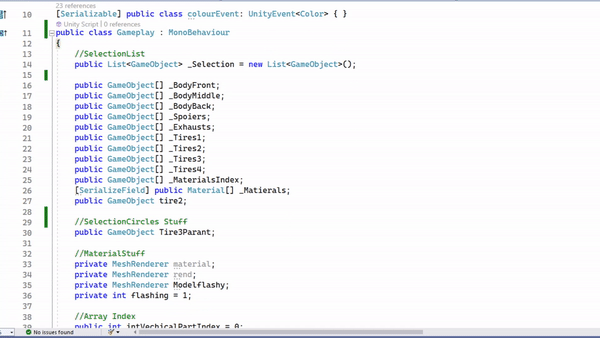Radioactive rev
Vehicle customisation is a significant feature of racing video games (Forza Motorsport 6, 2015; Need for Speed, 2010; Racing 2021). Although popular, many systems have remained similar in the last decade generally involving the player selecting from real-world conventional designed cars, many of which lack distinctiveness.
Radioactive Rev was developed in response. Currently in its alpha build, this game aims to offer control and possibilities to the player in customising its vehicles. The game presents the player with a range of hybrid animal and motor objects and parts that can be assembled and customised in various ways, allowing the player to construct and modify inventive and unusual vehicles.
Radioactive Rev attempts to bring not only a novel experience, but also player flexibility and creativity through its vehicle customisation system. Additionally, it also aims to broaden the generic genre of vehicle customisation that is currently in video games.
Project Versions Aiming to Find a Creative Builder Outcome
Radioactive Rev initiated from different concepts and theories to reach its current form. The first phase of development, Version 1, was dedicated to the exploration of original theories that had been conceived from my unique concepts. Unity was the chosen development platform for all iterations of this project.
This project was a solo one, including the art and the programming. I reached out to LookLuke for custom sound and music for the game. This project served as a significant component of my studies within RMIT's master's program and was completed within a concise timeframe of 12 weeks.
Prototype Version 1
Prototype Version 1 showcases a horizontal builder that empowers users to manipulate the vertical aspects of their vehicle by duplicating the body and altering the models to achieve their desired aesthetics. It also provides users with the capability to switch between various materials on the models through the texture mode.
This section of the prototype served as a proof of concept, demonstrating the user's ability to finely customise their vehicle. It allowed users to determine the number of tyres on the vehicle, adjust the placement of various components, and fine-tune the overall width and height of the vehicle, enhancing the level of creative control and customisation within the experience.
Prototype Version 1.5
Prototype Version 1.5 introduced a grid system that provided players with the freedom to position their components in any section of the grid. This design choice aimed to empower players by granting them flexibility in assembling their creations, enabling them to place components as they desired.
However, as the range of possible inventions became increasingly diverse, it became apparent that an excessive degree of choice could lead to an unmanageable and potentially frustrating gameplay experience. The game world had to be meticulously designed to accommodate both the largest and smallest vehicles, creating a challenging balancing act to ensure a satisfying player experience.
Prototype Version 2
Prototype Version 2 of the prototype introduced more structured player constraints compared to the previous iteration. This iteration placed a significant emphasis on enhancing user engagement through the use of dynamic camera animations to guide the player's attention. Additionally, it introduced the concept of asymmetric vehicles, providing players with a unique experience.
The user's journey in this version began by guiding them to place tyres on the screen. Subsequently, the interface transitioned to the opposite side, where players could continue to assemble their vehicle. A crucial insight emerged during this phase of development, leading to a decision to make the builder symmetrical in preparation for future iterations.
Following the tyre placement stage, players were encouraged to position connectors that facilitated the attachment of tyres to the vehicle's body. This version also enabled users to place the vehicle's body and the rear section, further enhancing the depth and complexity of the building process.
Radioactive Rev was made in unity.
Models made in Blender & ZBrush. Some Substance painter was used.
Code used for one of the scripts that handles selection, the array list, sounds and UI


